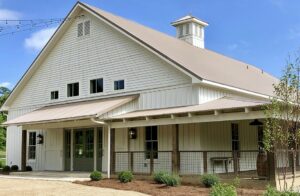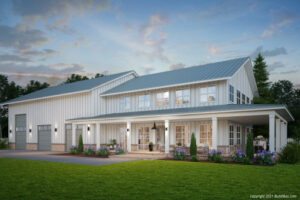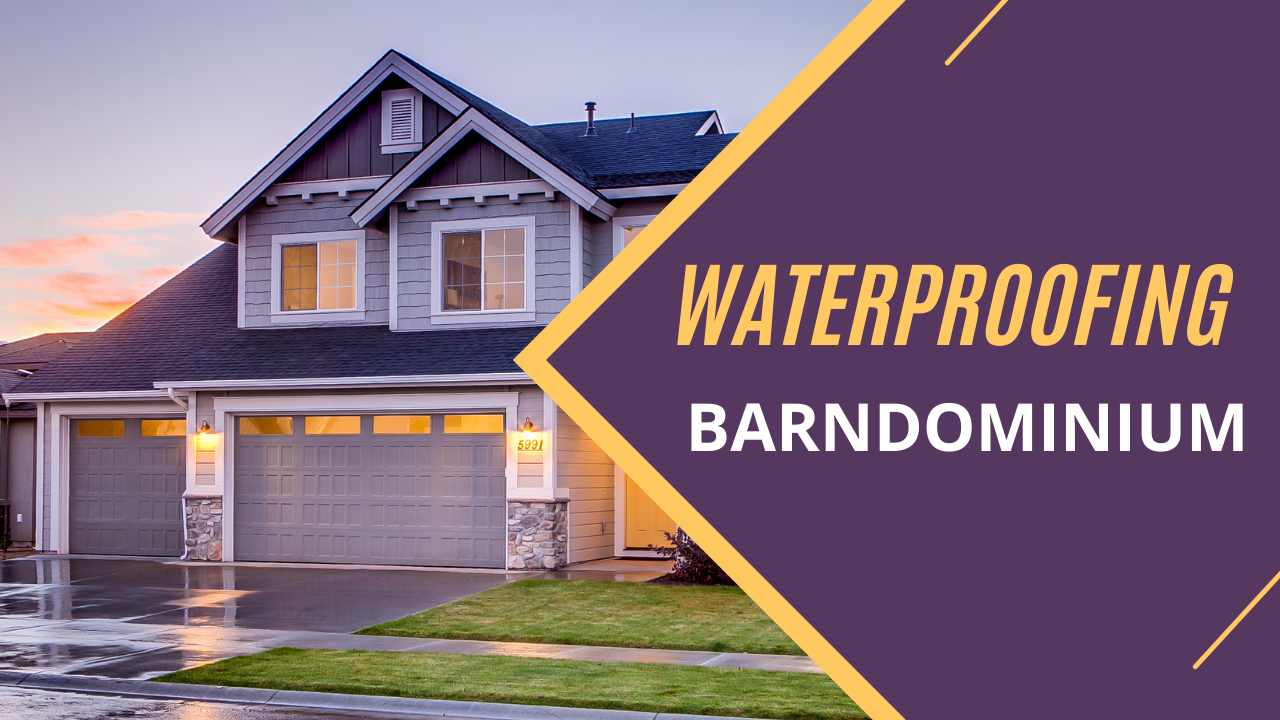A waterproofing barndominium is a unique and versatile type of building that combines the rustic charm of a barn with the modern amenities of a home. These structures have become increasingly popular in recent years, as they offer an affordable and spacious alternative to traditional homes. However, as with any building, waterproofing is essential to protect against water damage and preserve the integrity of the structure.
In this article, we’ll explore the importance of waterproofing barndominium and provide a comprehensive guide to the different types of waterproofing solutions available. Whether you’re building a new barndominium or looking to upgrade your existing structure, this article will provide the information you need to ensure your building is protected from the elements.
Assessing the Barndominium for Waterproofing

Before waterproofing barndominium, it’s important to assess the building to identify potential problem areas and evaluate the existing structure. This will help you determine the best waterproofing solutions to use and ensure that your barndominium is properly protected from water damage.
Identifying Potential Problem Areas
The first step in assessing your barndominium for waterproofing is to identify potential problem areas. These may include areas where water tends to accumulate or where moisture is likely to penetrate the structure. Common problem areas in a barndominium include:
- Foundation walls
- Windows and doors
- Roof penetrations (such as chimneys or skylights)
- Exterior walls (especially in areas with heavy rain or snow)
- Areas where the soil slopes toward the building
Conducting a Site Inspection
Once you’ve identified potential problem areas, the next step is to conduct a site inspection. This involves examining the building and the surrounding property to determine the best waterproofing solutions to use. During the inspection, you should consider:
- The slope of the land around the building and how water flows across the site
- The type of soil and how it affects drainage
- The location of downspouts and gutters
- Any existing drainage systems or sump pumps
Evaluating the Existing Structure
Finally, you’ll need to evaluate the existing structure to determine if there are any areas that need repair or reinforcement before waterproofing. This may involve examining the foundation for cracks or other damage, checking the roof for leaks, and inspecting the walls for signs of moisture damage. By addressing any existing problems before waterproofing, you can ensure that your barndominium is properly protected for years to come.
Choosing the Right Waterproofing Solution
When it comes to waterproofing barndominium, choosing the right solution is essential to ensure that the building is properly protected. There are several factors to consider when selecting a waterproofing solution, including:
Climate and Weather Conditions
The climate and weather conditions in your area can have a significant impact on the type of waterproofing solution you choose. If you live in an area with heavy rainfall or frequent snowfall, you may need a more robust waterproofing system to protect your barndominium from water damage.
Site Topography and Drainage
The topography and drainage of your site can also play a role in choosing the right waterproofing solution. If your property has a high water table or poor drainage, you may need to use a more extensive waterproofing system to ensure that your barndominium remains dry.
Type of Foundation and Wall Construction
The type of foundation and wall construction used in your barndominium can also impact your waterproofing choices. For example, if your foundation is made of concrete, you may need a different waterproofing solution than if it is made of wood.
Building Usage and Occupancy
The usage and occupancy of your barndominium can also impact your waterproofing choices. If you plan to use the building for storage or as a workshop, you may not need as extensive of a waterproofing system as if you plan to use it as a residence.
Common Waterproofing Materials
There are several common waterproofing materials that you can use to protect your barndominium, including:
- Liquid applied membranes
- Sheet membranes
- Bituminous membranes
- Polyurethane coatings
- Others
Each of these materials has its own advantages and disadvantages, so it’s important to consider your specific needs and requirements when selecting a waterproofing solution for your barndominium.
Waterproofing Techniques for Different Parts of the Barndominium

To ensure that your barndominium is properly protected from water damage, it’s important to use different waterproofing techniques for different parts of the building. Here are some of the most common techniques for waterproofing the foundation, walls, and roof of a barndominium:
Waterproofing the Foundation
The foundation is the most critical part of any building, and it’s essential to ensure that it is properly waterproofed. Here are some common techniques for waterproofing the foundation of a barndominium:
- Drainage Systems: Proper drainage is essential to prevent water from accumulating around the foundation. This can be achieved by installing a drainage system around the perimeter of the foundation, such as a French drain or a sump pump.
- Crystalline Waterproofing: This technique involves applying a crystalline waterproofing material to the surface of the foundation. The material penetrates the concrete and forms crystals that fill the pores, making the foundation waterproof.
- Cavity Drainage Systems: This technique involves creating a cavity between the foundation and the interior walls. Any water that penetrates the foundation is collected in the cavity and drained away.
- Bentonite Waterproofing: This technique involves applying a layer of bentonite clay to the foundation. When wet, the clay expands and forms a waterproof barrier.
Waterproofing the Walls
Water can also penetrate the walls of a barndominium, so it’s important to use the right waterproofing techniques to prevent this from happening. Here are some common techniques for waterproofing the walls of a barndominium:
- Exterior Wall Coatings: These coatings are applied to the exterior walls of the building and create a waterproof barrier. They can be made from a variety of materials, including acrylic, silicone, and elastomeric coatings.
- Water Repellent Sealers: These sealers are applied to the surface of the walls and create a hydrophobic barrier that repels water.
- Sheet Membranes: These membranes are applied to the exterior walls of the building and create a waterproof barrier. They can be made from a variety of materials, including rubber, PVC, and polyethylene.
- Spray Polyurethane Foam: This technique involves applying a layer of polyurethane foam to the exterior walls. The foam expands and creates a seamless, waterproof barrier.
Waterproofing the Roof
The roof is another critical part of a barndominium that requires proper waterproofing. Here are some common techniques for waterproofing the roof of a barndominium:
- Single-Ply Membranes: These membranes are made from a single layer of synthetic material and are applied to the roof in a single layer. They are lightweight and easy to install.
- Bituminous Membranes: These membranes are made from asphalt and are applied in layers to create a waterproof barrier.
- Liquid Applied Membranes: These membranes are applied as a liquid and then cure to form a seamless, waterproof barrier.
- Metal Roof Coatings: These coatings are applied to metal roofs and create a waterproof barrier. They can be made from a variety of materials, including acrylic, silicone, and polyurethane.
Maintenance and Repair
Even with the best waterproofing system, regular maintenance, and repair are still essential to ensure your barndominium remains fully protected from water damage. This section covers how to inspect for damage, clean and maintain your waterproofing system, and repair any damage that may occur.
Inspecting for Damage
Regular Inspection Schedule
To keep your waterproofing system in good condition, you should schedule regular inspections. The frequency of inspections will depend on factors such as the climate and weather conditions in your area, the age of the building, and the type of waterproofing system you have installed.
In general, it’s a good idea to inspect your barndominium for water damage at least twice a year – once in the spring and once in the fall. During these inspections, pay special attention to areas where water damage is most likely to occur, such as around windows, doors, and the foundation.
Signs of Water Damage to Look For
During your inspections, keep an eye out for signs of water damage, such as:
- Stains on walls or ceilings
- Musty odors
- Peeling paint or wallpaper
- Cracked or warped wood
- Visible mold or mildew
If you notice any of these signs, it’s important to take action right away to prevent further damage.
Cleaning and Maintaining the Waterproofing System
Cleaning Procedures
To maintain your waterproofing system, you should clean it regularly to remove dirt, debris, and other contaminants. The specific cleaning procedures will depend on the type of waterproofing system you have installed, but some general tips include:
- Using a soft-bristled brush or low-pressure washer to clean the surface
- Avoiding harsh chemicals or abrasive cleaners that could damage the waterproofing material
- Clearing gutters and downspouts to prevent water from pooling on the roof or foundation
Maintenance Tips
In addition to regular cleaning, there are several other maintenance tasks you should perform to keep your waterproofing system in good condition, including:
- Checking the drainage system for clogs or damage
- Inspecting the foundation for cracks or other damage
- Keeping trees and shrubs trimmed away from the building to prevent damage from falling branches or leaves
Repairing Damage
DIY vs. Professional Repairs
If you notice any damage to your waterproofing system during your inspections, you may be tempted to try to fix the problem yourself. While some repairs can be done on a DIY basis, others are best left to professionals. If you’re unsure whether you can handle a repair yourself, it’s always best to consult a waterproofing expert.
Repairing Cracks and Holes in the Foundation
One of the most common types of water damage in a barndominium is foundation damage. If you notice cracks or holes in your foundation, you must repair them to prevent water from seeping in. Some common methods for repairing foundation damage include:
- Patch and Fill Methods: For small cracks and holes, you can use a patching compound to fill in the damaged area.
- Waterproofing Coating Repair: If the damage is more extensive, you may need to apply a waterproofing coating to the entire foundation to ensure it is properly protected.
Roof Repair Techniques
If you notice any damage to your roof, such as missing shingles or leaks, it’s important to repair the problem right away. Some common roof repair techniques include:
- Patching: For small holes or cracks, you can use a patching material to seal the damaged area.
- Replacement: If the damage is more extensive, you may need to replace the damaged section of the roof.
- Coating: Applying a waterproofing coating to the roof can help protect it from future damage.
Cost and Time Estimates

Waterproofing a barndominium can be a significant investment in terms of both time and money. It is essential to plan and budget accordingly to ensure that the job is done correctly and efficiently. The cost and time estimates for waterproofing barndominium can vary depending on several factors.
Factors Affecting the Cost and Time of Waterproofing
The size of the barndominium, the extent of the waterproofing needed, and the materials used are some of the factors that can affect the cost and time estimates for waterproofing. Other factors that can impact the cost and time include:
- The complexity of the project: The complexity of the waterproofing project can have a significant impact on the time and cost estimates. For example, a barndominium with a complex design or intricate details may require more time and specialized materials, resulting in a higher cost.
- Accessibility: The accessibility of the barndominium can also impact the cost and time estimates. If the barndominium is in a remote location or has limited access, it may take longer and cost more to complete the project.
- Quality of materials: The quality of materials used for waterproofing can also impact the cost and time estimates. High-quality materials may cost more upfront, but they can provide better protection and last longer, resulting in lower long-term costs.
- Contractor experience: The experience of the contractor can also impact the cost and time estimates. A more experienced contractor may charge more but can complete the project faster and with fewer errors.
Budgeting for Waterproofing
When budgeting for waterproofing barndominium, it is essential to consider the cost and time estimates carefully. It is recommended to get multiple quotes from different contractors and compare the prices and services provided. It is also important to factor in any potential additional costs, such as repairs or maintenance, in the long term.
Conclusion
Waterproofing a barndominium is essential to protect the structure from water damage, which can lead to significant problems and costly repairs in the long term. This comprehensive guide has provided an overview of the various types of waterproofing techniques and materials, factors to consider when choosing the right solution, and maintenance and repair tips. Additionally, we have discussed the cost and time estimates for waterproofing and the importance of proper budgeting and planning.
By understanding the importance of waterproofing and implementing the appropriate techniques and materials, barndominium owners can ensure that their structure remains protected from water damage for many years to come.
Frequently Asked Questions (FAQs)
Q: How often should I inspect my barndominium for waterproofing issues?
A: It is recommended to inspect your barndominium for waterproofing issues at least once a year. However, if you notice any signs of water damage, such as leaks or mold growth, you should have it inspected immediately.
Q: Can I waterproof my barndominium myself, or do I need to hire a professional?
A: While some waterproofing techniques, such as applying a water-repellent sealer, can be done by a homeowner, it is generally recommended to hire a professional contractor with experience in waterproofing. This ensures that the job is done correctly and with the right materials, providing long-lasting protection against water damage.
Q: How much does it cost to waterproof a barndominium?
A: The cost of waterproofing barndominium can vary depending on several factors, including the size of the structure, the extent of the waterproofing needed, and the materials used. It is recommended to get multiple quotes from different contractors to compare prices and services provided.

